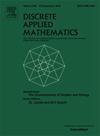Functions that are uniquely maximized by sparse quasi-star graphs, and uniquely minimized by quasi-complete graphs
IF 1
3区 数学
Q3 MATHEMATICS, APPLIED
引用次数: 0
Abstract
We show that for a certain class of convex functions , including the exponential functions with a real number, and all the powers , and a real number, with a unique small exception, if ranges over the degree sequences of graphs with vertices and edges and , then the maximum of is uniquely attained by the degree sequence of a quasi-star graph, namely, a graph consisting of a star plus possibly additional isolated vertices. This result significantly extends a similar result in Ismailescu and Stefanica (2002). Dually, we show that for a certain class of concave functions , including the negative exponential functions with a real number, all the powers , and a real number, and the function for , if ranges over the degree sequences of graphs with vertices and edges, then the minimum of is uniquely attained by the degree sequence of a quasi-complete graph, i.e., a graph consisting of a complete graph plus possibly an additional vertex connected to some but not all vertices of the complete graph, plus possibly isolated vertices. This result extends a similar result in the same paper.
求助全文
约1分钟内获得全文
求助全文
来源期刊

Discrete Applied Mathematics
数学-应用数学
CiteScore
2.30
自引率
9.10%
发文量
422
审稿时长
4.5 months
期刊介绍:
The aim of Discrete Applied Mathematics is to bring together research papers in different areas of algorithmic and applicable discrete mathematics as well as applications of combinatorial mathematics to informatics and various areas of science and technology. Contributions presented to the journal can be research papers, short notes, surveys, and possibly research problems. The "Communications" section will be devoted to the fastest possible publication of recent research results that are checked and recommended for publication by a member of the Editorial Board. The journal will also publish a limited number of book announcements as well as proceedings of conferences. These proceedings will be fully refereed and adhere to the normal standards of the journal.
Potential authors are advised to view the journal and the open calls-for-papers of special issues before submitting their manuscripts. Only high-quality, original work that is within the scope of the journal or the targeted special issue will be considered.
 求助内容:
求助内容: 应助结果提醒方式:
应助结果提醒方式:


